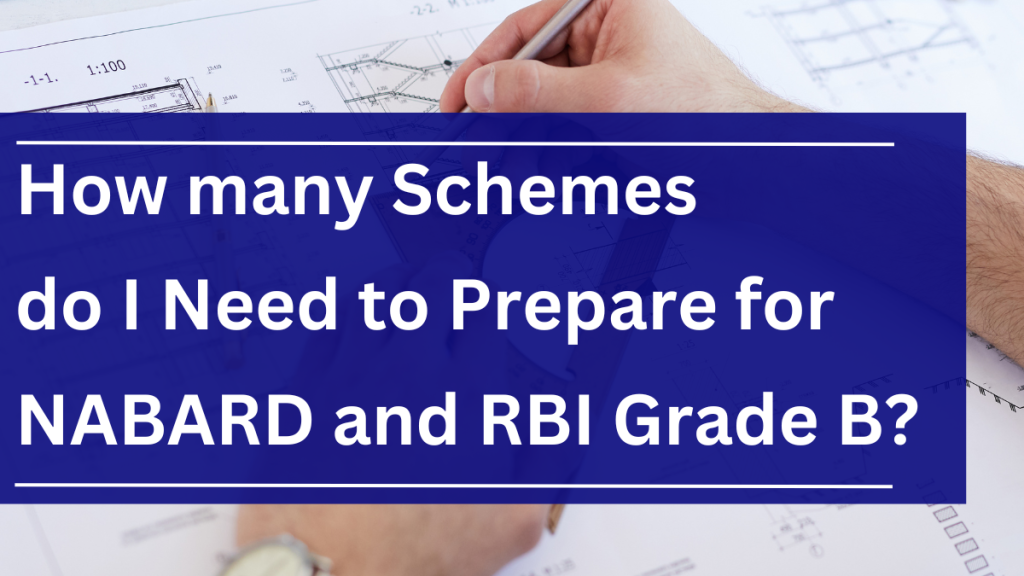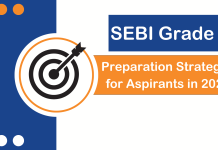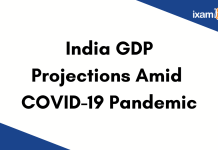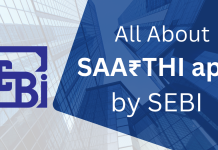The high-ranking NABARD and RBI Grade B exams are key targets for students aiming at careers in India’s financial and rural development sectors. These exams are tough, covering a wide range of subjects. One area that puzzles many is the long list of government plans. “How many plans do I need to know?” This is a common question among students starting their study journey. While it’s true that knowledge of government plans is crucial for both NABARD and RBI Grade B exams, the real skill lies in understanding, not just cramming.
First, let’s explore why these government initiatives are central. They fuel India’s socio-economic growth, covering areas from reducing poverty and agricultural advancement to boosting financial reach and rural infrastructure. Grasping these plans shows you’re in tune with the economic scene and able to assess the effects of government policies.

Interestingly, while both exams require awareness of these government plans, they focus on different areas. NABARD, which is centered on rural development and agriculture, stresses plans related to these fields, like the Pradhan Mantri Krishi Sinchai Yojana (PMKSY) or the Paramparagat Krishi Vikas Yojana (PKVY). On the other hand, the RBI Grade B exam, focusing on banking and finance, tends more towards schemes affecting these sectors, such as Stand-Up India or MUDQA.
Yet, the worry over overlooking an important scheme is a common concern among students preparing for either exam. This blog aims to clarify the study process for government schemes. We’ll show you a strategy that emphasizes understanding over sheer memorization, ensuring you excel in this key part of the NABARD and RBI Grade B exams.
The Strategy of Schemes for NABARD and RBI Grade B
Government schemes can feel like an overwhelming labyrinth for NABARD and RBI Grade B aspirants. But fear not! Here’s a strategic approach that prioritizes understanding over memorization, turning this section into your ally.
Ditch the Rote, Embrace the Why: Forget memorizing every minute detail of every scheme. Instead, focus on grasping the core objectives, target beneficiaries, and the impact each scheme aims to achieve. This in-depth understanding allows you to analyze schemes critically and discuss their effectiveness in the real world.
Organize for Efficiency: Categorize schemes by themes like agriculture, rural development, financial inclusion, and infrastructure. This creates a mental framework, making it easier to recall and compare relevant schemes during the exam.
Stay Ahead of the Curve: Prioritize current and high-impact schemes. Recent government initiatives often carry more weightage and demonstrate your awareness of evolving policies. Resources like the RBI website and official government websites are your best friends for finding the latest and most important schemes.
Remember, this is just the beginning. Following are some practical tips for effective preparation, including utilizing current affairs and news sources, understanding the interlinkages between schemes, and using mind maps for better memorization:
- Make current affairs and government announcements for your allies. Regularly follow credible news sources to stay updated on recent scheme launches and policy changes. This not only keeps your knowledge base fresh but also allows you to analyze the potential impact of these new initiatives. To stay up to date with general knowledge, you can explore ixamBee’s Beepedia with daily, weekly, and monthly updates on current affairs.
- Don’t get lost in the details. For each scheme, focus on understanding the core objectives, target beneficiaries, and the intended impact. This will equip you to answer questions that go beyond just naming the scheme and delve into its effectiveness.
- Government schemes are rarely standalone entities. Many are designed to work together for a bigger purpose. Identify the interconnections between schemes targeting similar goals. Understanding how these schemes complement each other will demonstrate a deeper level of understanding.
- Mind maps or flowcharts can be powerful tools for memorization and connecting different schemes. Create visual representations that showcase the relationships between various schemes under a particular theme. This not only aids in recall but also helps you identify potential overlaps and synergies.
Important Schemes for the NABARD Exam
To give you an idea of how to implement the above strategies to study relevant government schemes for the NABARD exam, we have picked a few important government schemes whose importance and impact are felt even today. Take a look at the schemes below:
Agriculture Infrastructure Fund (AIF)
Year Launched: 2020
Objective: To provide medium-long-term debt financing facility for investment in viable projects for post-harvest management infrastructure and community farming assets.
Launched by: Ministry of Agriculture and Farmers’ Welfare
Brief: The AIF aims to provide financial support to farmers, farmer-producer organizations (FPOs), agricultural entrepreneurs, and startups for the creation of post-harvest management infrastructure. This includes setting up of cold storage, collection centers, processing units, etc. The fund provides a medium-long term debt financing facility for these projects.
Sahakar Mitra – Scheme on Internship Programme
Year Launched: 2021
Objective: To provide paid internship opportunities to youth in cooperative institutions and to encourage youth to take up cooperative-based entrepreneurship.
Launched by: NABARD
Brief: The Sahakar Mitra scheme provides internship opportunities to youth in cooperative institutions. The internship duration is 3-6 months, and interns are provided a monthly stipend. The scheme aims to promote cooperative-based entrepreneurship and provide hands-on experience to youth in the cooperative sector.
Yuva Sahakar – Cooperative Enterprise Support and Innovation Scheme
Year Launched: 2019
Objective: To provide financial assistance and credit guarantee support to young cooperators to take up entrepreneurial activities, innovation, and modernization of cooperative business.
Launched by: NABARD
Brief: The Yuva Sahakar scheme provides concessional finance and credit guarantee support to young cooperators (age 18-40 years) to set up new cooperative enterprises or modernize existing ones. It aims to promote cooperative-based entrepreneurship and innovation among the youth.
Fisheries and Aquaculture Infrastructure Development Fund (FIDF)
Year Launched: 2018
Objective: To provide concessional finance for the development of fisheries infrastructure.
Launched by: Department of Fisheries, Ministry of Fisheries, Animal Husbandry and Dairying
Brief: The FIDF provides affordable credit to state governments, state entities, cooperatives, individuals, and entrepreneurs for the development of fisheries infrastructure, such as fishing harbors, cold chain, and aquaculture farms. This helps boost fish production and productivity in the country.
Pradhan Mantri Fasal Bima Yojana (PMFBY)
Year Launched: 2016
Objective: To provide comprehensive crop insurance coverage against crop loss due to various natural perils.
Launched by: Ministry of Agriculture and Farmers’ Welfare
Brief: PMFBY is a crop insurance scheme that provides coverage for crop loss due to natural calamities, pests, and diseases. It aims to stabilize the income of farmers and encourage them to adopt innovative practices in agriculture.
You can see that by categorizing relevant information regarding a scheme, you don’t have to go through pages and pages of information to study it. The name, year, ministry, and objective of the scheme suffice as basic introductions to a scheme. This method will help you cover a large number of schemes in a short period of time without being confused. Out of all the agriculture and rural development-related schemes by the government of India, which are important for the NABARD exam, some will stand out.
There will be a few schemes, either recent or old, which will have wider implications in the overall governance of the nation. It is those specific schemes where you should spend more time. These schemes include Pradhan Mantri Krishi Sinchai Yojana (PMKSY), Pradhan Mantri Kisan Samman Nidhi (PM-KISAN), and Micro Irrigation Fund (MIF). ixamBee helps you with all-round preparation for the NABARD exam through the NABARD online course, NABARD test series, and more.
Important Schemes for the RBI Grade B Exam
Following the same tips from above, the way we listed government schemes for the NABARD exam, in this section we will go through important schemes to cover the for the RBI Grade B exam.
Sovereign Gold Bond Scheme (SGB)
Year Launched: 2015
Objective: The aim is to decrease the demand for physical gold and encourage the allocation of a portion of domestic savings, traditionally used for gold purchases, into financial instruments.
Launched by: Ministry of Finance, Government of India
Brief: This scheme offers investors a mechanism to own gold in bond form rather than tangible assets. These bonds, expressed in gold grams, present an innovative pathway beyond conventional gold possession, alongside a prospect to accrue interest on the held investment. This arrangement not only aims to convert gold investors towards more fiscal mediums but also enriches the financial saving culture by embedding a value-generating option apart from the physical holding of gold.
Remission of Duties and Taxes on Exported Products (RoDTEP)
Year Launched: 2021
Objective: To refund the embedded central, state, and local duties/taxes that are not refunded under any other mechanism, to exporters.
Launched by: Ministry of Commerce and Industry, Government of India
Brief: The RoDTEP program aims to boost the global competitiveness of Indian exports by refunding the embedded taxes and duties on inputs for exports. It supersedes the previous Merchandise Exports from India Scheme (MEIS) and ensures exporters are reimbursed for all embedded taxes and duties, thus augmenting their competitive edge in global markets.
Marketing and Logistics Development for the Promotion of Tribal Products from the North-Eastern Region (PTP-NER)
Year Launched: 2021
Objective: To promote the marketing and branding of tribal products from the North-Eastern region and strengthen the logistics infrastructure.
Launched by: Ministry of Tribal Affairs, Government of India
Brief: This scheme strives to enhance brand awareness, better market reach, and fortify the supply network for these goods, thus promoting the earnings and living standards of tribal groups. This initiative undertakes to mold a more robust economic environment for indigenous products, guaranteeing their rightful place in the competitive market while respecting the unique cultural heritage they represent.
Mahila Samman Savings Certificates, 2023
Year Launched: 2023
Objective: To provide a savings instrument for women, with a higher interest rate and partial withdrawal facility.
Launched by: Ministry of Finance, Government of India
Brief: The Mahila Samman Savings Certificates, 2023, is a recent savings plan launched by the Indian Government to boost financial growth and power for women. This scheme provides a higher interest rate than most other minor savings options and permits some amount to be taken out early, making it a beneficial saving choice for women.
Pradhan Mantri Vaya Vandana Yojana (PMVVY)
Year Launched: 2017
Objective: To provide social security during old age and protect elderly persons aged 60 years and above.
Launched by: Ministry of Finance
Brief: The PMVVY, managed by the Life Insurance Corporation of India (LIC), ensures a steady pension ranging from ₹1,000 to ₹5,000 monthly for those aged 60 and older, spanning a period of 10 years. This program guarantees a fixed return rate of 7.4% per annum for the fiscal year 2020-21, offering financial stability and predictability.
Other important schemes from the point of view of the RBI Grade B exam include Bharat Bill Payment System (BBPS), Financial Inclusion Fund (FIF), Unified Payments Interface (UPI), Insolvency and Bankruptcy Code (IBC), Atal Pension Yojana (APY) and a few more. You can supplement your exam preparation with ixamBee’s RBI Grade B online course, RBI mock tests, and many more.
Conclusion
Our journey through a strategic plan to grasp government projects for the NABARD and RBI Grade B exams has placed focus on deep knowledge rather than just learning by heart. This method lifts you to a place where you can examine and judge these policies with a keen eye. Keep in mind, government policies and schemes are just one piece of the puzzle in these broad exams. Candidates are also tested on their math skills, logic, and English. Moreover, showing your clear thinking and ability to solve problems is key to doing well. To help you with this ixamBee offers numerous resources like quantitative aptitude quizzes, English language basic concepts, and other resources like free mock tests and previous year papers.
The foundation of strong preparation is building a solid grasp of the main goals, who these projects are for, and the change they aim to make. This insight, together with recognizing how different plans intersect, will prepare you to shine in this area and others.
So, as future experts in finance and rural growth, start your study path with certainty. By following the strategies we’ve discussed and focusing on understanding, you’ll be in a strong position to tackle the NABARD and RBI Grade B exams.
To help you prepare 50% faster for competitive exams, ixamBee provides a free Mock Test Series and all the Current Affairs in English and Current Affairs in Hindi in the BeePedia capsules for GA Preparation. You can also get the latest updates for Bank PO, Bank Clerk, SSC, RBI Grade B, NABARD, and Other Government Jobs.
Also Read:
What are some dos and don’ts for the RBI Grade B exam?
Government Schemes for NABARD Grade A
NABARD Grade A Best Study Material: How To Prepare for Finance















